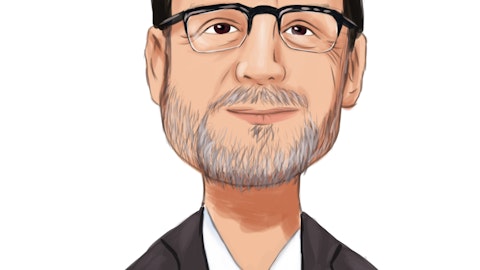Maximus, Inc. (NYSE:MMS) Q4 2022 Earnings Call Transcript November 22, 2022
Maximus, Inc. beats earnings expectations. Reported EPS is $1.13, expectations were $0.69.
Operator: Greetings, and welcome to the Maximus Fiscal 2022 Fourth Quarter and Year-End Earnings Conference Call. At this time, all participants are in a listen-only. A brief question-and-answer session will follow the formal presentation. As a reminder, this conference is being recorded. It is now my pleasure to introduce your host, Jessica Batt, Vice President of Investor Relations and ESG for Maximus. Thank you. Ms. Batt, please go ahead.
Jessica Batt: Good morning and thanks for joining us. With me today is Bruce Caswell, President and CEO; David Mutryn, CFO; and James Francis, Vice President of Investor Relations. I’d like to remind everyone that a number of statements being made today will be forward-looking in nature. Please remember that such statements are only predictions. Actual events and results may differ materially as a result of the risks we face including those discussed in Item 1A of our most recent Forms 10-Q and 10-K. We encourage you to review the information contained in our most recent filings with the SEC and our earnings press release. The company does not assume any obligation to revise or update these forward-looking statements to reflect subsequent events or circumstances, except as required by law.
Today’s presentation also contains non-GAAP financial information. Management uses this information internally to analyze results and believes it may be informative to investors in gauging the quality of our financial performance, identifying trends, and providing meaningful period-to-period comparisons. For a reconciliation of the non-GAAP measures presented, please see the company’s most recent Forms 10-Q and 10-K. And with that, I’ll hand the call over to David.

Photo by rupixen.com on Unsplash
David Mutryn: Thanks, Jessica, and good morning. We ended fiscal year 2022 on a high note, reflecting the growing momentum in our core business. Signed contract awards in the company were at an all-time high, which includes securing the CCO rebid totaling $6.6 billion, a record signing for Maximus. Our contract backlog also stands at an all-time high of $19.8 billion. The short-term COVID response work has concluded as anticipated, and the management team is energized and focused on executing our recently refreshed strategy. As noted in our press release, total company revenue for fiscal 2022 increased 8.9% to $4.63 billion. This is net of a decline in COVID response work of approximately $800 million compared to fiscal 2021.
Adjusting for this normalized organic growth was approximately 18%, which came from new or expanded programs in all three segments. The other source of top line growth was full period contributions from the Attain Federal, Veterans Evaluation Services and Aidvantage acquisitions in the U.S. Federal segment. On the bottom line, the full fiscal year 2022 adjusted operating income margin was 9.0%, which, as a reminder, adds back only the intangibles amortization expense. Adjusted EPS again only adjusted for intangibles amortization was $4.37. Our earnings exceeded the high end of the guidance range we provided in August due to the combined benefits in the fourth quarter, totaling $28 million, or $0.33 per share. First, several contractual and legal items were resolved in the quarter.
This resulted in a $17 million benefit, or $0.20 of earnings per share, and split roughly evenly between the U.S. services OI, the U.S. Federal Services OI, and the other line item which represents items that are not allocated to a particular segment. Second, there was an $11 million or $0.13 EPS one time gain on sale related to our former headquarters, which was finalized in the fourth quarter. And given the nature of this transaction, we did not include any gain in our prior guidance range. In addition to those benefits, it’s worth noting that the VES business and U.S. Federal had notably strong performance, more than offsetting the PACT Act related investment I spoke to you last quarter. I’ll now take you through segment results. Starting with our largest segment U.S. Federal Services.
For the U.S. Federal Services Segment revenue increased 19.4% to $2.26 billion. The total growth was driven by full period contributions from the 3 acquisitions I mentioned, partially offset by the decline in short-term COVID work. New work wins and expansion on recompetes examples of which include the additional region one in VES, the SEC modernization effort announced last year with expanded scope and the CMS contact center operations recompete with higher run rate drove a normalized organic growth rate in the segment of 4.8%. The operating income margin for U.S. Federal Services was 10.4% in fiscal 2022 as compared to 10.0% in the prior year. As I mentioned, the segment’s fourth quarter earnings were bolstered by approximately 1/3 of the contractual and legal items.
For the U.S. Services segment, revenue decreased 3.3% to $1.61 billion. Normalized for the COVID work decline, organic growth in the segment was over 30% driven by new work wins and are successful conversion of some short-term work into longer term contracts. Examples include eligibility support contracts in Indiana and Arkansas, long-term care assessment work across the country and a multi-year unemployment insurance contract with California. The U.S. Services operating income margin was 11.3% for the full year with the segment’s fourth quarter earnings bolstered by approximately 1/3 of the contractual and legal items. As I mentioned, margins for the segment were lower in the second half of fiscal 2022 as the COVID response work concluded.
Meanwhile, redetermination activities tied to Medicaid, which have been paused since 2020 under the public health emergency continued to be a headwind to the segment’s profitability. I’ll cover our redetermination assumptions in the fiscal 2023 discussion. For the outside the U.S. segment, revenue increased 9% to $764 million. This is net of currency impacts, which reduced revenue approximately 6%. Organic growth was about 11% and driven primarily by volume increases on the U.K. Restart program, as it ramped over the course of the fiscal year. The segment realized an operating loss of $15 million for fiscal 2022, due to the unfortunate rebid outcome in Australia, which included severance costs, and the write down on a percentage of completion project that we described in the third quarter.
Let’s turn to the balance sheet and cash flow items. As of September 30, 2022, we had gross debt of $1.37 billion, and we had unrestricted cash and cash equivalents of $41 million. We paid down approximately $128 million of debt in the fourth quarter, which brought our debt ratio to 2.6 times at September 30, down from 2.9 times at June 30. As a reminder, this ratio is our debt net of allowed cash to pro forma EBITDA for the last 12 months, as calculated in accordance with our credit agreement. Let me speak to our capital allocation strategy. While strategic acquisitions remain a core focus of our strategy over the broader horizon, in the near-term, we plan to prioritize debt paydowns using our free cash flow. We had strong cash flows in the fourth quarter to finish the year.
Cash flows from operating activities totaled $290 million and free cash flow was $234 million. Day sales outstanding or DSO were 62 days at September 30, 2022, compared to 68 days for the same day last year. As a result of an increasing portion of our revenue coming from the U.S. Federal government, our DSO range is now 60 to 70 days, down from the 65 to 80 days that we have historically targeted. Let’s go to fiscal year 2023 guidance. Revenue is projected to be between $4.75 billion and $4.9 billion. Adjusted operating income is estimated to be between $390 million and $415 million, which is before the estimated $94 million of intangibles amortization expense. Adjusted EPS, excluding intangibles amortization is projected to be between $3.70 and $4 per share.
There are two important factors to note in this guidance. First, the guidance range does not reflect any redetermination activities across the entire fiscal year 2023. As a brief reminder, the National Public Health Emergency which has been extended in 90-day increments since January 2020 provides enhanced Medicaid funding and other benefits to states. A condition of receiving that funding is that states are precluded from performing eligibility checks, known as redeterminations on their Medicaid population. With many of our state contracts, the redeterminations generate billable volumes, which are accretive to the U.S. services segment. We have been precluded from performing redeterminations since early fiscal 2020 due to the public health emergency.
Currently, there is no projected date for resuming redeterminations so we have excluded any benefit from our guidance. While we still estimate a $0.15 to $0.30 per quarter benefit to EPS once redetermination start, we felt this approach was prudent given this as a factor outside of our control. Once there is better visibility to the end of the public health emergency, which could be announced in fiscal year 2023, there will be upside to guidance. The precise impact will depend on the exact timing of the emergency exploration as well as factors that I discussed last quarter, including how the volumes will flow through our programs and outstanding operational decisions by state customers. The second important factor is that short-term COVID response work, which has provided temporary benefit and enhanced cash flow to the two U.S. segments in prior periods has come to an end.
Therefore, there is no short-term COVID response we’re contributing to our forecast for fiscal 2023. Reflecting on the revenue guidance, the $4.825 billion midpoint represents mid-single digit growth over fiscal 2022, while also overcoming $300 million of erosion from short-term COVID response work. The primary drivers are a combination of new work wins in fiscal 2022 and higher — reflects core work replacing the short-term COVID response work. And we are still below the earnings potential of the company given the ongoing public health emergency and no redeterminations assumed across the year. This is why our margins are rolling up to below the 9% low end of the target adjusted margin range for the company that we laid out at our Investor Day in May, and which was based on our expectations for when the PHE is over.
The adjusted EPS guidance includes between $85 million and $95 million of interest expense, which equates to about $40 million to $50 million of incremental cost compared to last year. As mentioned earlier, our total debt balance at September 30 was $1.37 billion. We entered into a second interest rate swap in October, bringing our total portion that is effectively fixed to $500 million from $300 million previously. I’ll briefly share our forecasts on segment margins, which remain in line with expectations we communicated at the May Investor Day. We expect our U.S. Services segment to be between 8% and 10% for the year. The ending of the PHE is required to bring this segment into its target range of 11% to 14%. We expect the U.S. Federal Services margin to be in the 10% to 11% range, which is consistent with fiscal 2022 results and within the target range of 10% to 12% for this segment.
Finally, we expect outside the U.S. operating income margins at the low end of the 3% to 7% target range which improves on fiscal 2022 position. This segment is anticipated to have more stability in fiscal 2023 thanks to strong core programs in place, and less disruption caused by residual pandemic factors. On the broader topic of margins, I’d like to offer some commentary on a topic we are often asked about, which is the impact of inflation to our financial profile. Our largest cost is labor, and we have experienced rising market wages. Approximately 30% of our revenue comes from cost plus contracts, where we are reimbursed for all costs, meaning rising wages drive higher revenue with little impact to the bottom line. For the remainder of our contracts, we have seen some margin erosion in the past year to varying degrees.
Our government contracts are typically priced over multi year periods, and include labor rate escalators on the order of 2% to 3%. Market conditions have led us in some cases to raise wages more in the 4% to 5% range, and that difference puts pressure on our margins. Therefore, we estimate that the margin impact we have experienced from higher wages is 1% to 2%. This has been felt particularly in our U.S. services segment, which has predominantly fixed price and performance-based contracts. So the impact in this segment is at the high-end of that range. We typically prefer long-term fixed price contracts, as they give us the opportunity to drive efficiency and improve margins over the life of the contract. In an era of high inflation, however, we bear the risk until the next repricing opportunity.
As we have bid on new contracts over the past year, we have been able to price in higher labor rates, meaning we expect to recapture margin over time. Last point, labor costs are only one of many factors that drive margins on our fixed price contracts. We continue to drive efficiencies through process improvement and technology. Turning to our quarterly profile, I want to point out that we expect a lighter first quarter of fiscal 2023 as compared to the fourth quarter of fiscal 2022, which included some positive items that won’t recur, most notably the gain on sale of our old headquarters, and the resolved contractual and legal item. Also in the first quarter of fiscal 2023, we expect higher severance than normal driven by recently executed cost reduction initiatives.
From a cash flow standpoint, we expect free cash flow between $225 million and $275 million for fiscal 2023. Let me note that our expectation for the first quarter is relatively flat free cash flow, given seasonal factors as well as our second of two payments for the payroll tax deferral that we elected under the 2020 Cares Act, which is about $28 million. Our free cash flow conversion should continue to be at least 1.3 times GAAP net income, which reflects the significant non-cash items such as intangibles amortization and stock compensation, as well as the low capital requirements of our business. The full year effective income tax rate should be between 24.5 and 25.5%. And weighted average shares should be between 61.2 and 61.3 million. With that, I will turn the call over to Bruce.
See also 12 Best Tech Stocks for Long-Term Growth and 12 Tech Stocks with Biggest Upside.
Bruce Caswell: Thank you, David and good morning, everyone. As David’s remarks underscore while we continue to operate in an environment influenced by federal policy decisions, FY ’22 affirms several fundamentals that investors have come to count on in our business model. These include, first, our ability to grow our core business through significant new contract wins. Second, the highly recurring nature of our revenue as evidenced by the great confidence our customers express through rebid awards. And third, our disciplined M&A strategy, through which we create the next platforms for organic growth, aligned with our refreshed 3 to 5 year strategy and catalyzed particularly by our acquisitions of attain and veterans evaluation services or VES.
As we look ahead at FY ’23, Maximus continues to be well positioned for organic growth, and to deliver on our near and midterm operating income margin commitments. While moving into a period of stability as we transition progressively out of a more volatile time. Our stability and reliability in an uncertain time is evidenced in our core business, where we operate long-term contracts for agencies with large budgets focused on citizen services. These contracts are largely either entitlement programs or essential government functions. Our portfolio of contracts has a weighted average life of eight years, and our new work win rate is strong. Our re compete win rate is more than 90%. Speaking first of the new work we secured as COVID work declined.
Within U.S. services, we announced in Q2 a $425 million contract with the Indiana Family and Social Services Administration. I’m pleased to report that our project teams worked closely with the customer to seamlessly transition to program during Q4 from the incumbent to Maximus, experiencing minimal turnover in personnel, and no interruption to customer service. Transitions of this nature are complicated. And having this completed in advance of the PHE unwinding was a clear customer priority. I’m proud of the Maximus team as we once again demonstrated our ability to smoothly take over the operations of a complex mission critical contract. Our VES business expanded in FY ’22 with nearly $400 million total contract value or TCV, awarded across District 6 and 7 and volumes increasing solidly through Q4.
As we work through existing cases in anticipation of new cases related to the PACT Act in early calendar year 2023. Further in U.S. services, we successfully converted several contracts originally secured to support short-term COVID unemployment insurance work to longer term relationships, including a more than $200 million TCV contract in California. These and other new work wins across all three segments enable us to more than overcome COVID reductions and deliver mid-single digit growth of 4.2% at the midpoint of our guidance range in FY ’23. This gives us confidence in our longer-term commitment to sustainable mid-single digit organic growth. Turning to recurring business, two recent successful repeats, where CCO and CDC, which I’ll speak more to now.
In September, we announced that Maximus was awarded the contact center operations or CCO award by the Centers for Medicare and Medicaid Services. The total value of the contract with just over a 9-year period of performance is $6.6 billion. This award reflects the commitment of thousands of Maximus employees who each day provide exceptional service to their fellow citizens. More recently, we successfully want to recompete with the Centers for Disease Control and Prevention or CDC. Under the contract, which has an awarded value of $100 million over five years, Maximus will leverage its technology capabilities and operational improvement skills for the CDC info program, which provides critical health information to millions of Americans. Both wins are key drivers in our contract backlog which stands at an all-time high of $19.8 billion.
With respect to FY ’23, in particular, the number of programs up for rebid is lower than normal, adding further stability to our forecast for the coming fiscal year. Coming out of this volatile period, we remain focused on our customers with whom we enjoy stable partnerships as we carry out the critical programs for which we are responsible. As I mentioned, the volumes in our VES business remain high. While we work closely with the VA to reduce current caseload in anticipation of further increased volumes due to the PACT Act. The VA has already begun receiving benefit applications as a result of the PACT Act, and we expect to see the corresponding downstream requests for disability examinations in early calendar year 2023. With respect to a advantage, our student loan servicing program, we are diligently managing staffing levels while remaining fully prepared for both return to repayment and the Biden administration’s Debt Relief Program, once a final determination is made in the courts.
We have a long-standing partnership to support the Department of Education Federal Student Aid, focusing on the end-to-end borrower experience and helping to fulfill their mission. Finally, broadly speaking, our U.S. services state-based Medicaid and AKA related programs continue to deliver solid operational performance with no significant rebuilds of key contracts on the horizon. As a provider of Medicaid eligibility related services to more than a dozen state and independent enrollment services to many others. We are well positioned to support the PHE unwinding when it eventually occurs. In the meantime, we continue to evolve the clinical aspects of that business in support of our 3 to 5 year strategy, successfully supporting our customers with complex, conflict free independent assessment services.
As David mentioned, we’ve made the conservative decision to prepare our FY ’23 forecast excluding any presumed benefit from Medicaid redeterminations. We continue to work closely with our clients to be ready to respond when the PHE is lifted. As we’ve noted before, we anticipate that our customers will vary in their approaches to the PHE unwinding, when it occurs. Taking advantage in some cases of federal waivers that are available and the timelines and guidelines that have been designed by HHS to maximize continuity of coverage. Our delivery model can accommodate these varied approaches demonstrating our agility and ability to meet our customers’ needs. In some cases, we expect the process of fully re determining eligibility across the state’s Medicaid population to take up to one year once it commences.
I’d like to underscore our anticipated financial resilience during a potential downturn in the economy. Our balance sheet is strong. Our business model providing essential government services enables high cash generation and conversion due to modest capital requirements. And our portfolio of contracts gives us confidence, stability, and continued growth through different cycles in the broader economy. Our progress expanding our addressable market to include state administered unemployment insurance programs, during the pandemic puts us in a strong position to assist those customers again, in the event of sector or regional unemployment increases. Finally, incorporated in our FY ’23 guidance and underpinning our post PHE. And midterm margin outlook is our commitment to structuring Maximus to best support our strategy.
What this means is that in normal course, from our project operations to our back-office functions, we will continue to carefully manage our costs and drive efficiencies in the business. Each business segment is taking a fresh look at their expenses. And we are reviewing our corporate support functions to ensure they aligned with our goals and are optimal for our organization now and into the future. To be clear, the leadership team is focused on meeting our margin commitments we articulated on our May Investor Day. I will now turn to award metrics and pipeline as of September 30th. For fiscal 2022, signed awards totaled $10.5 billion of TCV. Further, at September 30th, there were $800.1 million worth of contracts that had been awarded but not yet signed.
These awards translate into a book to bill of approximately 2.3 times. Let’s turn our attention to our pipeline of opportunities. Our pipeline at September 30 was $30.7 billion, compared to $32.5 billion reported in the third quarter of fiscal 2022. The September 30 pipeline is comprised of approximately $3.4 billion in proposals pending $3.1 billion in proposals in preparation and $24.2 billion in opportunities tracking. Of our total pipeline of sales opportunities, 74% represents new work. Additionally, 57% of the 30.7 billion in total pipeline is attributable to our U.S. Federal segment. When we unveiled our refreshed strategic priorities in March, we communicated a total addressable market of $150 billion in annual value. Going into FY ’23, our teams heavily scrutinized our pipeline to ensure the opportunities being actively worked aligned with our strategy.
I’m pleased to share that we are already seeing an increase in opportunities specifically related to our strategy. The investments we’ve made in our people and expertise are driving a focus on our strategy, particularly in the areas of clinical services and technology solutions. As part of my closing remarks, I’d like to take a moment to congratulate the nearly 11,000 Maximus employees on the CCO contract on the success of their first day of open enrollment for coverage under the affordable CARE Act. Our valuable and dedicated employees handle more than 35 million calls a year from those seeking AKA coverage through the Health Insurance Marketplace. Open enrollment for which kicked off on November 1st. On day one, our team’s answered incoming calls with no disruption in service for the 10s of 1000s of Americans seeking information and to sign up for these essential health benefits.
I’m proud to note that more than 95% of consumers that day reported they were satisfied with the service they received. A record level since the creation of the marketplace. Thank you, Maximus team, for your ongoing commitment to the consumers you serve, and our CMS customer. Finally, let me conclude where I began. We ended FY ’22 with growing momentum in our core business supported by organic expansion in all segments, and the full year contributions of our FY ’21 acquisitions. These achievements enable us to overcome the revenue reduction we see as short-term COVID work exits our portfolio, we enter FY ’23 with a record backlog a healthy pipeline, strong core business delivery, minimal near-term rebid risk, and solid progress delivering the business in a tough interest rate environment.
While we cannot precisely forecast the outcome of policy measures, like the PHE unwinding or student loan debt relief, our operating model designed to maximize variable cost with modest capital requirements, positions as well to respond when these issues resolved. Finally, we are already seeing the organization embrace and respond to our 3 to 5 year strategic plan to which many contributed as evidenced in our pipeline of new work opportunities and wins. As scale again builds in the business, we are committed to growing margins ahead of revenue and structuring the company optimally for the future. And with that, we’ll open the line for Q&A. Operator?
Operator: Thank you. We will now begin the Q&A session and I’ll turn it over to James Francis.
Q&A Session
Follow Ventura Coastal Corp (NYSE:MMS)
Follow Ventura Coastal Corp (NYSE:MMS)
James Francis: Good morning. Welcome to the Q&A session. We will first go to the line of Charlie Strauzer with CJS Securities. Charlie, do we have you?
Charlie Strauzer: Just starting off with David, if I could, just if you have the organic growth rates for Q4 by segments? That would be helpful.
David Mutryn: Sure, yes. For the company, organic growth in Q4 was about 3%. That reflects overcoming COVID Work declining by nearly $200 million from the year ago quarter. So normalized for the COVID work decline, organic growth is about 25%. And that’s strong in all three segments at over 50% in U.S. services, 13% in U.S. federal and 15% in outside the U.S. Those are all normalized for the COVID decline.
Charlie Strauzer: Got it. And David, maybe a little bit more color to on some of these the one time not benefits you saw on the quarter, the building scale, and if you talk a little bit more about what some of those benefits were?
Bruce Caswell: Sure, and Charlie it’s Bruce. I’m going to start and then turn it over to David. So the nature of some of these items precludes us from sharing too much detail, but let me give you some color on the contractual items that I mentioned and highlight that. For that one in particular we came to an agreement with a customer who I can’t name them, essentially reflected are working with them to reach an equitable adjustment for a contract that was bid well prior to the pandemic. And so consequently, we were facing higher costs than had been in our BID model for labor. And it was a very difficult and unanticipated operating environment caused by the pandemic. I’m really pleased with that outcome. It’s an example. As I said before, if are going and engaging with our customers, when we have a situation like that, where a contract needs to be adjusted, amended to reflect current, the current environment.
We worked in partnership with them to negotiate that modification. And it better reflects the lessons learned from implementing the contract and also more current labor market realities. David, anything to add?
David Mutryn: Yes, just for the contractual and legal items, the $0.20 of diluted EPS impact. I’ll just clarify that the combined pickup of those in Q4 was a reversal of charges that were mostly incurred in prior periods. So while the benefit is outsized in the fourth quarter results, it is reflective of higher operating profitability on the affected contracts. And speaking to the $0.13 real estate transaction, I view that as more truly one time and more of a non-operating item, since our former headquarters is the only building that we owned.
Charlie Strauzer: And then just looking at your call for adjusted operating margins of 8.3% to 8.5%, this coming year. What needs to happen, obviously, aside from redeterminations, to get those numbers higher, going forward?
David Mutryn: As you said, obviously, the PHE expiring in the redeterminations are the key component to meeting the committed margin ranges. And that would be the biggest piece. I will share as well and anticipation of our guidance, we had run a forecast scenario for the PHE ending in January. And for the post PHE period, we would still forecast adjusted OI margins in the ranges that we provided at Investor Day, for each segment and the nine to 12% range for the total company. Let me also point out on Slide 9 of the earnings presentation, there’s a chart that crosswalk fiscal year ’22 results to the midpoint of our fiscal year ’23 guidance. And as we’ve been saying, the COVID work was at a higher-than-average margin. But at this point, it’s behind us.





